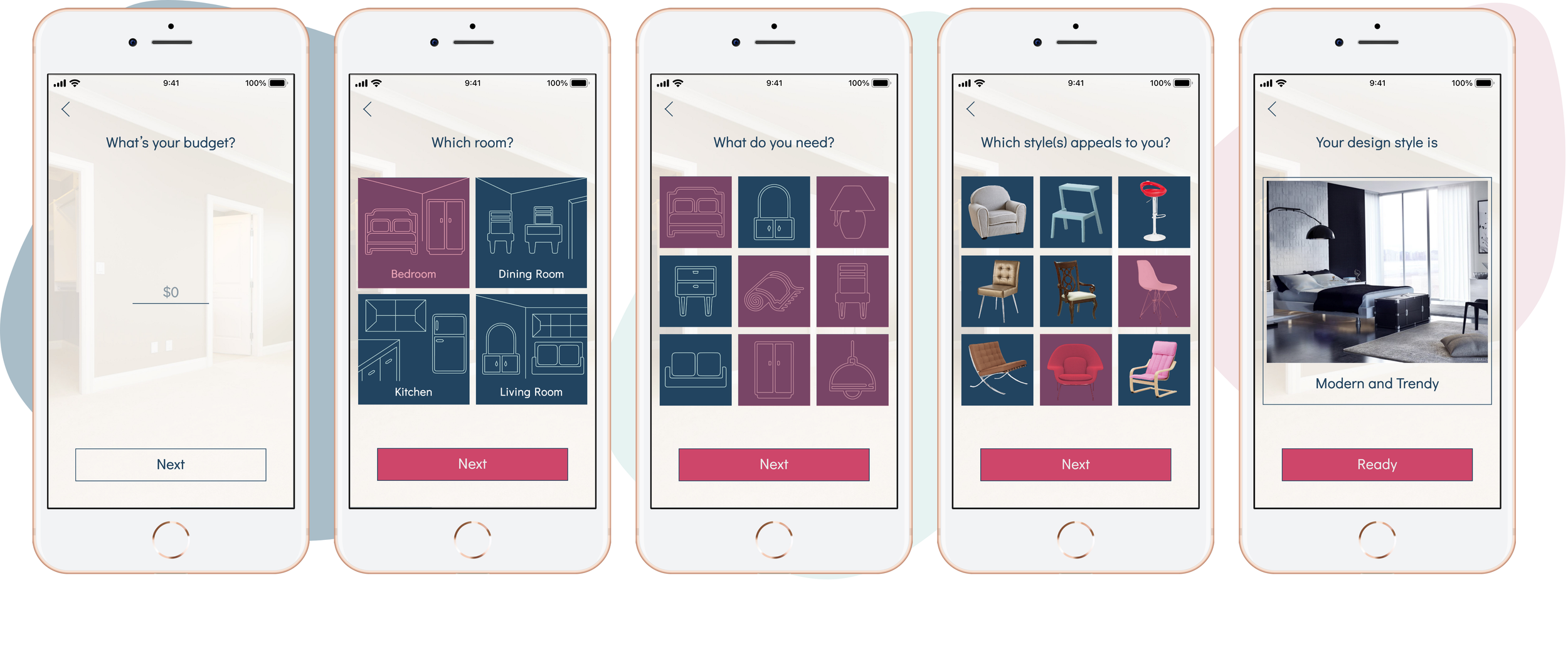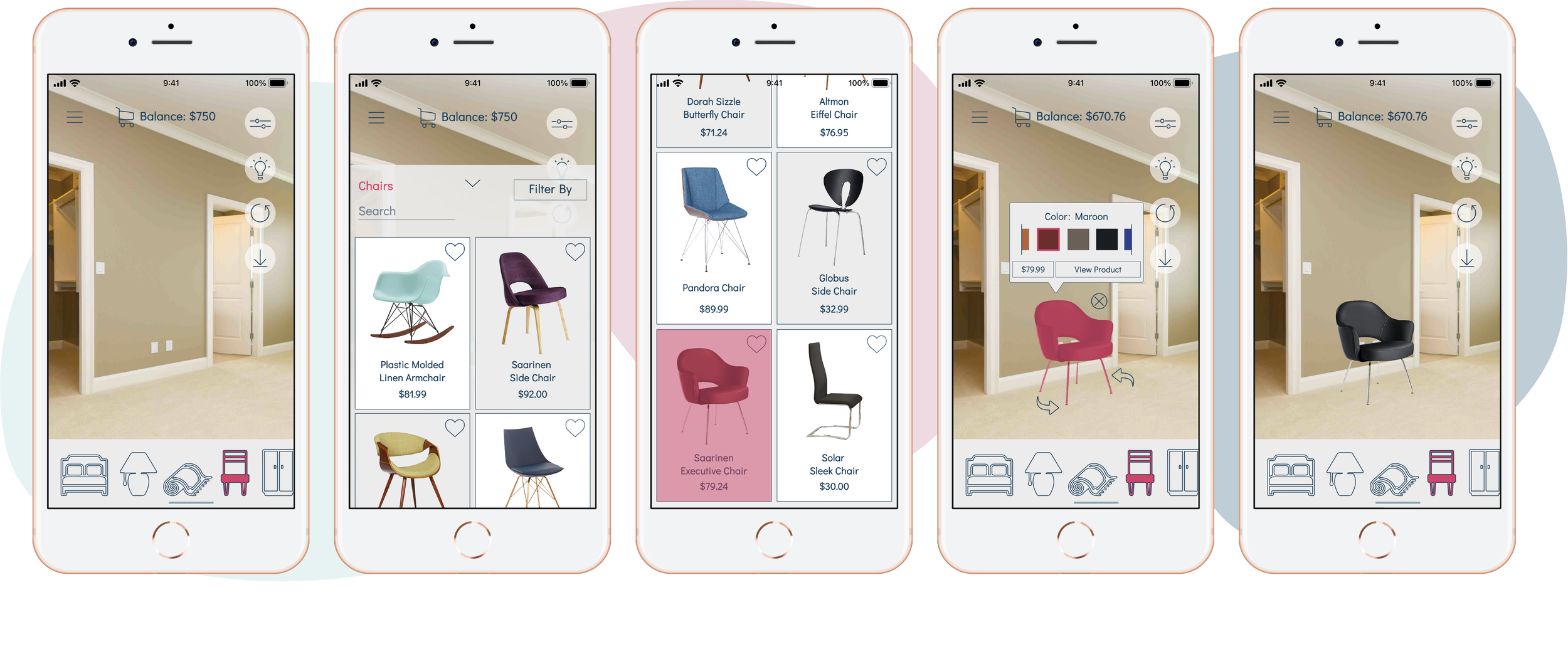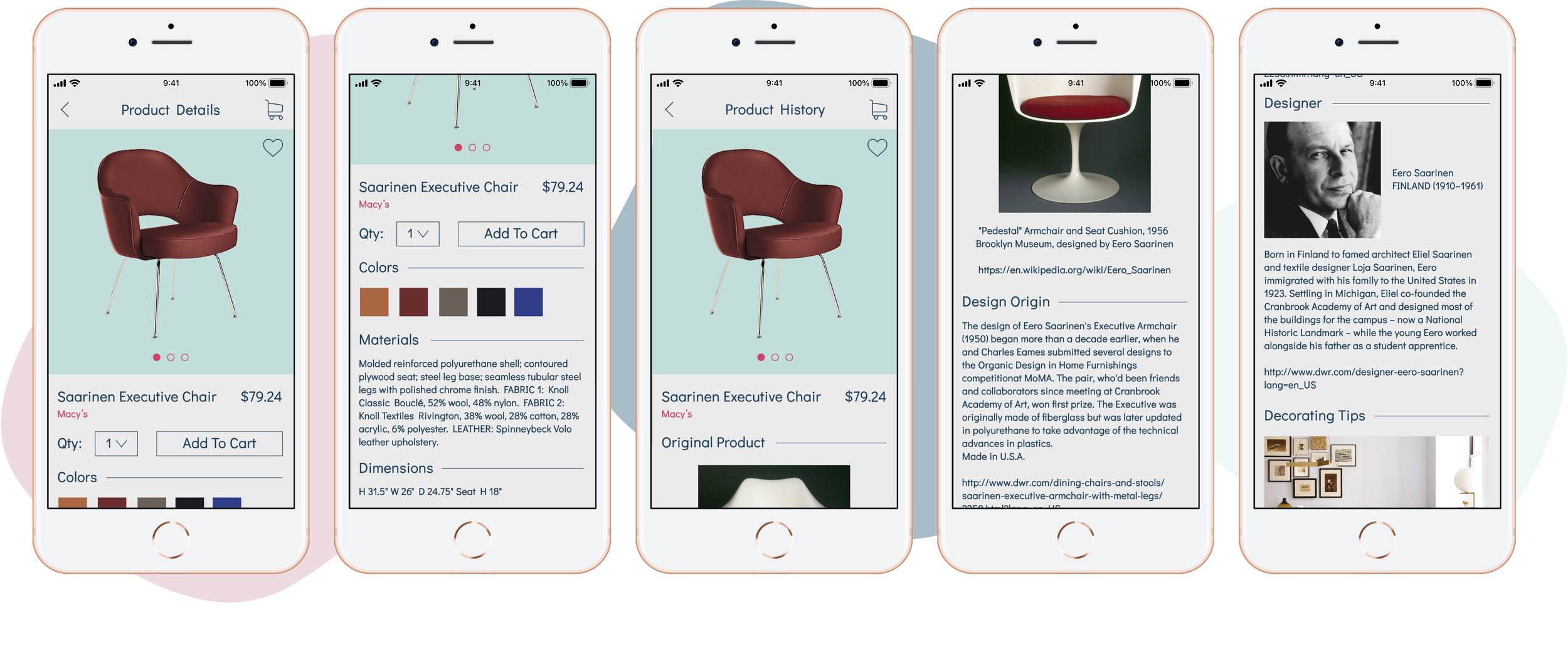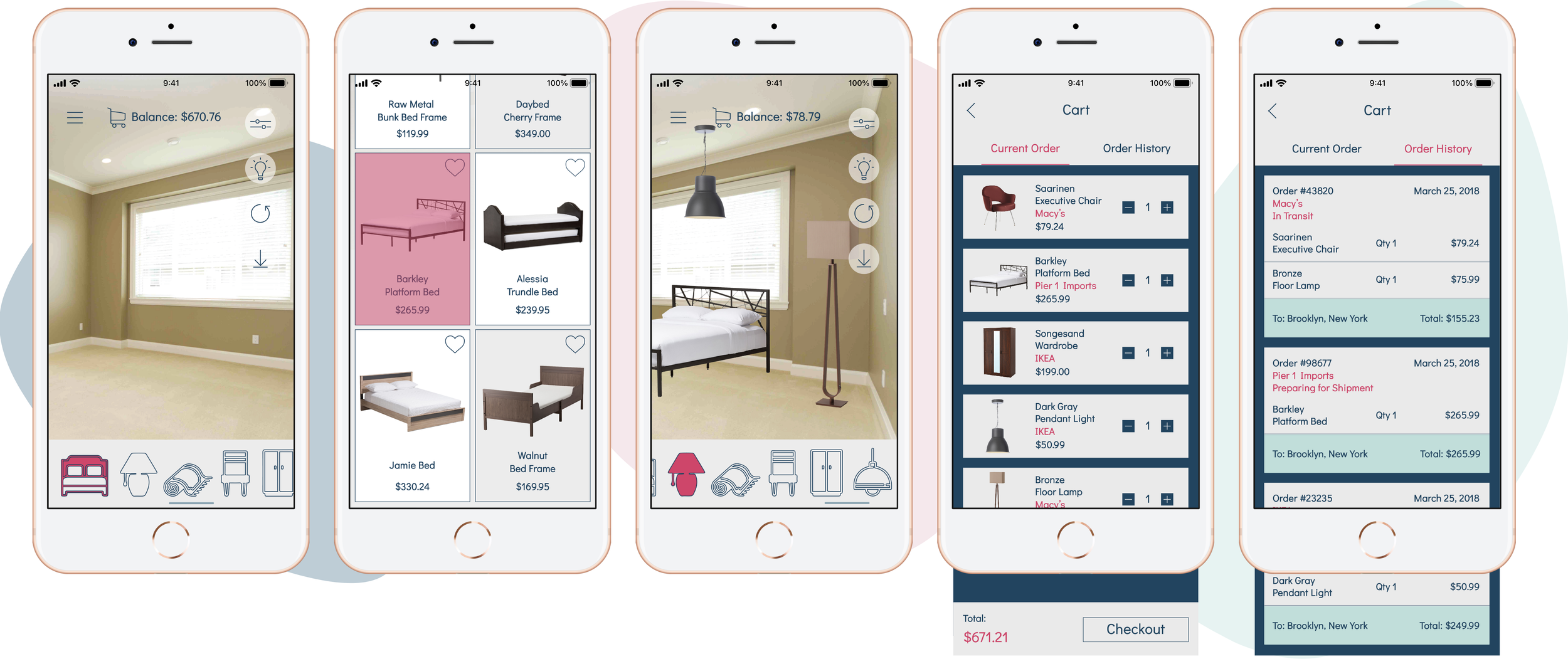Responsibilities
• User research
• UX/UI design
• Wireframing
• High-fidelity designs
Project Context
• Parsons senior thesis
• Solo project
• Fall 2017 - Spring 2018
Tools
• Sketch
• Adobe Illustrator
• Adobe Photoshop
• InVison
Overview
This project was a part of my senior Parsons core class: BFA Communication Design thesis. The course consolidates the students' previous three years of learning into a self-guided project that showcases their critical thinking and design abilities.
I decided to combine my passion for UX/UI design and a curiosity in immersive technology to create an augmented reality app.
Problem
Recent college graduates and young professionals
have a tough time furnishing their apartment due to
a lack of money, time or design skills.
Many college students, including myself, have been living in dorms all 4 years. All dorms are fully furnished with essential equipment. As soon-to-be recent graduates, it is likely that many of us will start from scratch by moving into an apartment once we land our first job. This sparked a couple of questions:
• Once we find a place, where do we look for furniture on a budget?
• Do we have the time to decorate our space(s)?
• How do we decorate and personalize our space(s)?
Solution
Design an intuitive and user-friendly app that improves the experience of furnishing an apartment while offering a high degree of confidence in the decision-making process.
1. Budget
• Add your total budget at the beginning
before designing a space.
• Once the camera opens up to your
space, the total budget is fixed at the top
of the viewport to remind users of their
balance.
• As furniture is added onto the space/in
the cart, the budget automatically
adjusts.
2. Select, Personalize & Design
through Augmented Reality
• Select the specific space, furniture and
style(s) you are interested in.
• An algorithm is developed and matches
the user's aesthetic to the app's
inventory, allowing for customized items
to display within the bottom nav bar.
• Design the space you’d like by placing
furniture anywhere in your space through
the AR feature.
• The AR feature provides quick and
accurate sizes/colors/styles for each
furniture piece displayed in your space.
3. Purchase
• APT has a partnership with 3rd party
retailer stores.
• Once all furniture pieces are selected
and placed in the space, users may
navigate to the cart icon.
• The cart displays furniture pieces
selected in a current order summary
where you may check out directly on the
app.
• User’s can track their current order or
revisit their order history.
Research
To narrow down my research, I explored competitors, defined my target audiences, and conducted interviews.
The results allowed me to target specific issues and
address pain points in order to create a more compelling
and unique app that is valuable to specific users.
1. Competitive Analysis
I closely analyzed three popular furniture apps that included a built-in augmented reality experience.
I learned that all three AR experiences were not as captivating, nor did they have any concept of budget or design guidance.
This was my opportunity to create a strong solution and build a unique and efficient experience.
2. Target Audience
I defined my primary and secondary target audience.
I then took a closer look into both target audiences:
For recent graduates,
I researched:
• The average number of
students enrolled in
universities in the US
• The number of degrees
awarded
• The average salary received
For young professionals,
I researched:
• The average salary earned
• The average age of
apartment renters
3. User Interviews
My interviewees were more likely to succeed in furnishing their own space(s) when they had the complete freedom to choose affordable furniture options and use virtual visualization tools.
I interviewed six individuals.
3 Recent graduates:
21 year old who received their
BS in Engineering from Rutgers University22 year old who received their
BFA in Fashion Design from Parsons School of Design22 year old who received their
BBA in Finance from University of Houston
3 Young Professionals:
A 26 year who is 4 years into their professional
career as a front-end developer.A 24 year old who is 2 years into their professional
career as a dietitian.A 23 year old 1 year into their professional
career as a graphic designer.
Questions:
What type of housing are you currently in?
How important is budget-friendliness when it comes to furnishing your living space(s)?
Do you shop for furniture and home decor online? If so, where?
How do you find inspiration for designing your living space(s)?
Have you encountered any challenges when trying to furnish your space(s) on a budget since graduating/as an employee?
Would you appreciate virtual room visualization (AR) features in an app to help plan your living space(s)?
What specific furniture items and/or styles are a priority for you as you set up your space(s)?
What specific features or services would make a furnishing app more appealing and useful for you?
Top Key Insights
Affordability is a Priority
Users highly prioritize affordability when furnishing their living space(s), and they are actively seeking budget-friendly options.
Design Matters
Aesthetics and design are essential considerations for users, even when they have budget constraints. They want stylish and visually pleasing options.
Convenience is Key
Users are looking for convenient ways to browse, purchase, and arrange furniture and decor items without investing excessive time and effort.
Interest in Virtual Visualization
There's a significant interest in AR or virtual room visualization tools that help users visualize how furniture will fit into their space before making a purchase.
Education and Resources
Users may benefit from educational content and resources on budgeting, decorating tips, and sustainable furnishing practices.
User Journey Map
Objective: To help make the experience of furnishing an apartment seamless and efficient for recent graduates and young professionals.
Ideation
I sketched out initial ideas of the app. I explored the flow of the account/log in section, the augmented reality feature by adding furniture in one’s space(s), adding items in the cart and the checkout experience.
User Flow
In order to help understand the sequence of actions, I explored a clear visual representation of how the users would navigate through the app. I created a flow chart for the general flow of the app, and then a detailed flow for the AR experience.
User Testing and Improvements
Based on user testing and feedback from 7 peers and my professor, I regularly iterated my designs over the span of 10 weeks.
There were 3 major improvements in my designs.
1. Shifting furniture selection
from sidebar navigation to
bottom navigation bar.
• Based on user testing, most users
preferred to hold their phone with one
hand. The bottom navigation bar was
easily reachable with the user’s thumb.
• Adding a horizontal scroll allowed for
displaying content efficiently since there
were many items to showcase within
limited vertical space.
2. Displaying custom furniture
options that align with the
user’s style preferences.
• Initially, users would choose a preset
theme. This limited furniture style
choices.
• Allowing users to select different
furniture style(s) they liked generated a
personal design style.
• This makes the app more user-centric,
visually appealing, and relevant.
3. Keep total budget fixed
above.
• Originally, the budget would hide within
the menu.
• After user testing, the budget was the
most important users cared about.
• Keeping the budget fixed above the
screen would remind users of their
budget as they add items in space/cart.
• Budget updated in real time when
furniture was added in space/cart.
The Final Product




Try the prototype yourself here!
UI Style Guide
Reflections
I confidently delivered my thesis project presentation before a panel of three judges.
While embarking on my first solo design project, I was prepared to encounter many challenges. Stepping outside my comfort zone to dive into the realm of UX/UI design for my thesis created a profound blend of excitement, hesitation, and curiosity.
I gained comprehensive insights into the research and discovery phase, all the way down to the stages of user testing, prototyping, and designing.
As I begin my career journey, I am confident that my work on this thesis has prepared me for the realities
of the professional world.
What Would I Do Differently?
Account for Accessibility
Accessibility wasn’t prioritized while designing, especially while deciding colors. Learning more about web accessibility standards and principles would’ve allowed me to create stronger designs that are inclusive and usable by all individuals.
Stay Updated and Informed
Staying updated on current UX/UI design trends, tools, and best practices by reading blogs, attending webinars, and taking online courses would’ve helped me create more compelling UI designs that would be more relatable.
Have More Faith in Myself
Since this was my first solo project, I was nervous I wouldn’t think of a unique project. I would compare myself with other peers, which reduced my confidence. Over time, I learned that I needed to trust myself more and use the skills I’ve learned in my 4 years at Parsons. I am thankful to have asked for help and receive feedback from my peers and professor.

